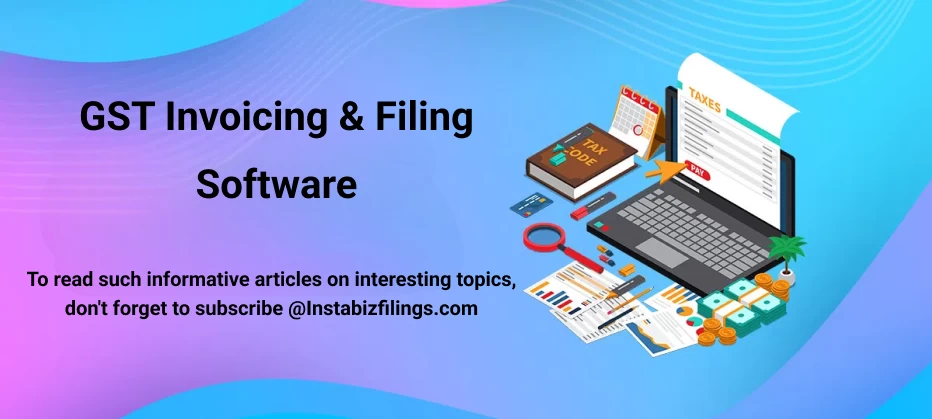
GST Invoicing & Filing Software
February 14, 2025 by Team Instabizfilings
GST in India has simplified taxation by establishing guidelines for billing and return reporting required for business compliance. Businesses generate complex challenges when it comes to managing GST invoices together with GST return filing and e-way bills and accounting operations. Modern GST software like LEDGERS as well as alternative accounting solutions makes these processes easier and more accurate. This document provides step-by-step instructions about GST invoices alongside returns management and the relevant software solutions.
What is a GST Invoice?
During the Goods and Services Tax (GST) regime the supplier along with the recipient require a GST invoice to document details about taxable transactions. The GST invoice works as evidence for the transaction of goods or services between parties and maintains essential position for Indian businesses to fulfill their tax obligations.
Types of GST Invoices
-
Tax Invoice: This is the most common type of invoice used by registered taxpayers. It contains details such as the seller and buyer’s GSTIN, the goods or services sold, their value, and the applicable GST rate (CGST, SGST, IGST).
-
Bill of Supply: For businesses that are not required to charge tax or are under the Composition Scheme, a Bill of Supply is used instead of a tax invoice. It is also used when there is no tax applicable to the supply.
-
Revised Invoice: If an error is made on a previously issued invoice, a revised invoice is issued to correct the mistake.
-
Receipt Voucher and Payment Voucher: These are used to document advance payments for goods or services and are typically issued for transactions where payment is made before the supply.
GST Return Filing
GST return filing is a mandatory process for all registered taxpayers to report their business transactions and tax liabilities under the GST law. The returns include detailed information about sales, purchases, output tax, input tax credit (ITC), and more.
Key GST Returns:
-
GSTR-1 (Sales Return): This return reports all outward supplies (sales) made by the business. It must be filed monthly or quarterly, depending on the turnover. GSTR-1 includes detailed information on the goods and services sold, their value, and the GST charged.
-
GSTR-3B (Monthly Return): This is a simplified monthly return where businesses report their GST liability and the input tax credit (ITC) they have claimed. GSTR-3B must be filed by all businesses, regardless of their turnover.
-
GSTR-9 (Annual Return): This return summarizes the data reported in GSTR-1 and GSTR-3B for the entire financial year and is filed once a year. It is an annual summary that helps ensure compliance.
-
GSTR-4 (For Composition Scheme): This is specifically for businesses registered under the GST Composition Scheme. These businesses pay tax at a fixed rate and do not claim input tax credits.
-
GSTR-8 (E-commerce): For e-commerce operators, this return is filed to report the supplies made through the e-commerce platform.
GST Return Filing Process:
-
Obtain all invoice and receipt information including sales records and purchasing documents and taxation data.
-
The GST portal together with accounting software handles the filing of GSTR-1 together with GSTR-3B reports. Enter all tax data accurately into the system for tax liabilities, ITC claims mixed with other essential information.
-
The payment of GST should happen before return submission when output tax exceeds input tax credits.
-
Submit the returns electronically via the GST portal. After submission to the GST portal the returns become nonmodifiable.
What is an E-way Bill?
The e-way bill is a system introduced under GST to track the movement of goods. It is mandatory for the movement of goods worth more than ₹50,000 (subject to exemptions), and it helps reduce tax evasion by ensuring that goods are not moved without proper documentation.
When is an E-way Bill Required?
-
When transporting goods worth more than ₹50,000.
-
For interstate and intrastate transport of goods.
-
For movement of goods by the seller, transporter, or recipient of goods.
How to Generate an E-way Bill?
-
Login to GST Portal: Go to the GST portal and login with your GSTIN.
-
Enter Details: Enter details like invoice number, date, consignment value, transport mode, and consignor/consignee details.
-
Generate E-way Bill: After submitting the details, the system will generate an e-way bill with a unique 12-digit number.
-
E-way Bill Validation: The goods can only be moved if the E-way Bill is validated. It must be kept with the consignment during transportation.
GST Software and Tools
Using manual methods to manage GST compliance tasks leads to high time consumption along with increased possibility of human errors. Businesses can use GST software solutions from LEDGERS and other similar accounting tools to simplify their GST-related workflows that include invoicing document creation and return submission and e-way bill creation and many other necessary tasks.
Key Features of GST Software:
-
The software system automatically creates GST-compliant invoices that include GST, taxable value and CGST, SGST and IGST rates.
-
Users can prepare their GST returns (GSTR-1, GSTR-3B) exactly from the software platform for accurate and prompt filing procedures.
-
The system enables enterprises to automatically monitor and determine Input Tax Credit (ITC) for their purchased goods through its ITC calculation process.
-
The system permits users to generate and control e-way bills which simplify goods movement compliance.
-
GST software tracks all business operations through an Audit Trail function which supports effective handling of audits while handling assessments.
-
Tax calculations through automation produce precise results which reduces errors between output tax and input tax credit.
Multiple GST software solutions available on the market include LEDGERS, Tally ERP 9, QuickBooks, and Zoho Books.
LEDGERS - GST Software for Compliance and Accounting:
The powerful accounting application LEDGERS helps businesses streamline their GST compliance as well as their accounting processes and tax management needs.
Key Features of LEDGERS:
-
The application generates GST-compliant invoices automatically through its system to track all monetary operations.
-
The platform provides a direct system to file GSTR-1 and GSTR-3B GST returns.
-
LEDGERS facilitates smooth operations by linking with bank accounts and payment gateways and additional accounting programs.
-
LEDGERS enables users to create e-way bills and conduct their management from within the system interface.
-
The system enables users to produce different audit-relevant GST and financial reports for examinations.
Accounting Software for GST Compliance
GST filing processes and bookkeeping management along with tax compliance operate at their peak because of accounting software tools. Entrepreneurs across all industry sizes can use these tools to keep track of financial records as well as file returns while managing GST invoices.
Popular Accounting Software for GST:
-
Tally ERP 9 represents a widely used accounting software that comes with all essential GST functionalities to produce invoices and manage return submissions alongside tax computation capabilities.
-
The cloud-based accounting program QuickBooks allows businesses to generate GST-compliant invoices and file required returns.
-
Users of Zoho Books can create GST-compliant invoices while the system calculates taxes automatically and simplifies returns filing.
-
FreshBooks provides a simple interface that helps users create GST-compliant invoices(new and improved tax reporting functions).
Payment Gateways for GST-Related Transactions
Payment gateways serve as secure systems which enable businesses to obtain transactions securely from their customers. All e-commerce businesses together with service providers and anyone who handles online payments need payment gateways to operate their systems effectively. Some payment gateway solutions link directly with accounting platforms alongside GST platforms for automated transaction processing and GST compliance tracking.
Popular Payment Gateways for GST Transactions:
-
Razorpay provides simple GST invoicing system integration as well as tax transaction management solutions for businesses.
-
Using Paytm Payment Gateway businesses can process GST-compliant payments while receiving integrated accounting system tracking of their transactions.
-
A popular payment gateway with GST integration, suitable for businesses of all sizes.
Conclusion
Businesses encounter difficulties when handling GST compliance through GST invoices and return filing and e-way bills while performing tax calculations. Advanced GST software systems such as LEDGERS together with reliable accounting software enable businesses to automate these processes which maintains their compliance status with GST regulations. The integration of payment gateway tools with your accounting system leads to precise payment and tax reconciliation among other benefits that payments gateways provide for smooth online transactions.
Businesses that use modern technologies generate time efficiency and reduced errors alongside accurate financial documentation of operations.
Disclaimer
The information provided in this blog is purely for general informational purposes only. While every effort has been made to ensure the accuracy, reliability and completeness of the content presented, we make no representations or warranties of any kind, express or implied, for the same.
We expressly disclaim any and all liability for any loss, damage or injury arising from or in connection with the use of or reliance on this information. This includes, but is not limited to, any direct, indirect, incidental, consequential or punitive damage.
Further, we reserve the right to make changes to the content at any time without prior notice. For specific advice tailored to your situation, we request you to get in touch with us.


